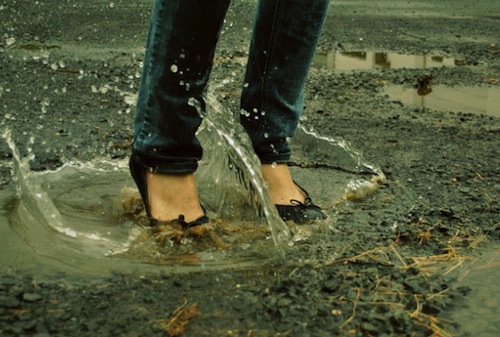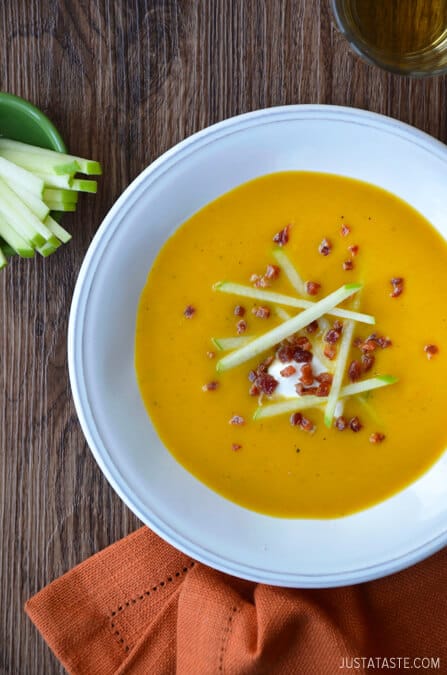"I would put one in but it doesn't rain enough here."
I...what? What are you saying? What are you even talking about right now? We live in the same state. Do you really not know?
Oh god you really do not know. Oh, wow. Well, this is embarrassing, because listen:
Myth #1: California does not get enough rain for meaningful water reclamation.

Okay, yes, GRANTED. This is a picture of California, and it looks bad. We are currently in one of the worst droughts in recorded history. We are in such a bad drought that ARIZONA is going to ship us some water. Arizona. That's the desert out east of Hollywood. I think the national plant might legit be a tumbleweed. You know what they have in Arizona? Signs that say "Turn off air conditioning for next 5 miles" because it's so hot there your car might explode. I'm extrapolating a little bit on that but I'm pretty sure spontaneous combustion is a recorded thing in Arizona. And they are giving us water. That's the kind of (dry) creek we're up right now. The brown areas on the map above bleed into reddish brown areas which are letting you know you may live in a place where trees are more likely to burst into flames that burn down your house than to shade you. It's dry here. Is what I'm saying.
So when the severe water restriction mandates went into effect this spring, I became hyper aware of all the places I might get water or recycle water or just use water more wisely--and then it rained, unexpectedly, a whole half inch. There were some spots along the side of my house where water was dripping, since, like most of the houses on my block, we don't have full roof gutters, just about ten feet protecting the entryway; so I threw some buckets and watering cans under the drips and then an empty trashcan under the biggest downspout. I thought I might collect a gallon or two altogether and get enough to water the tomatoes the next week.
I came back a few hours later and every bucket was overflowing along with my thirty gallon trashcan.
I started getting excited and ran out to scramble up another empty trashcan. Since we'd let the lawn die and we'd started composting, the green waste trashcan was just sitting there empty. I stuck it under the downspout too.
Filled to the top.
WHAT THE HELL.
I watched sadly as the slow storm continued to pour off my roof, unchecked; I'd run out of containers to catch it with. Everything I owned that could hold water was holding water, down to the lids for the trash cans themselves, and still it was spilling out everywhere--all from a half inch of rain.
If I had big enough barrels, how much could I have actually caught?
The formula, says Arizona Waterwise, is the square footage of your roof x the amount of rain in inches x 0.623. So for example, for a 1000 square foot roof, a half inch of rain yields over 300 gallons of rainwater. In 2014-2015, the dry year that led us into this historic drought, San Diego still received around 9 inches of rain. That's over 5400 gallons of rain that could be collected just from one medium sized house even in the midst of a historic drought. To put it into perspective, you could water a 1000 square foot lawn for 9 weeks straight with that much water. If you include the 9 weeks of water your lawn got from being rained on, you end up with 4 and a half months that you don't need to water that lawn.
Now if you have a garden....
Myth #2 A Garden takes more water than a lawn
Are you serious right now? I can't tell if you're serious.
I've mentioned before that my neighbors are awkwardly involved in every thing I do in my garden (and chicken coop, and mini-coop construction shoppe) and one of them recently asked us "How are you managing to keep those vegetables watered when we we're not supposed to water more than once a week?"
You're worried about my garden when your yard looks like this?

While it's true that some parts of the garden have the same water requirements as the lawn (an inch a week) garden plants have some specific advantages over green lawns when it comes to reducing your water consumption.
Now if you have a garden....
Myth #2 A Garden takes more water than a lawn
Are you serious right now? I can't tell if you're serious.
I've mentioned before that my neighbors are awkwardly involved in every thing I do in my garden (and chicken coop, and mini-coop construction shoppe) and one of them recently asked us "How are you managing to keep those vegetables watered when we we're not supposed to water more than once a week?"
You're worried about my garden when your yard looks like this?

While it's true that some parts of the garden have the same water requirements as the lawn (an inch a week) garden plants have some specific advantages over green lawns when it comes to reducing your water consumption.
- First of all, even with six raised beds and five fruit trees I don't even come CLOSE to filling up the entire space my lawn took up. While someday I hope to have expanded into the full lawn space I still won't use every bit of my square footage because of the extra space I have to give up to paths and the unused space between plants. For this year, even with all I have in the garden, I changed my water usage from over 10,000 gallons a week for my lawn to 175 gallons a week for my food garden.That means a single storm that drops even a half inch of water will cover my garden for two weeks, and with the rain itself and what I can collect in my barrels, a drought rainfall of 9" in a year will still cover me for 36 weeks out of the year--in other words, the entire growing season.
- Second, fruiting plants shade themselves. My squash vines grow super densely and they and my bean plants grow spade shaped umbrella leaves perfectly suited to shading their fruits. Tomato plants even when they're staked twine together and shade each other. They keep the ground from getting hot enough to let the water evaporate.
- Mulching around garden plants retains water that can be released slowly into the ground over time, and reduces evaporation even more. I use cedar chips, pine needles, and dead leaves; anything that can protect the soil and will decompose and add nutrients back into the soil. While you *could* do this with a green lawn by letting the grass clippings fall back down into the lawn, it detracts from the bright green color and makes the lawn look dead--and since curb appeal is a huge reasons for having the lawn in the first place, using a mulch totally defeats the purpose.
Myth #3 The upcoming El Nino Storm will end the drought
Even though scientists are calling this winter's coming storm a "Godzilla" El Nino, the biggest storm in about fifty years, it still will not be enough to end the drought. Warm waters off the coast may counteract some of the strength of the storms, lessening torrential rains to soaking showers. While that sounds good in terms of reducing the risk of floods, our groundwater reservoirs are so depleted they'd need several deep, heavy rains to even begin replacing the deficit. Because the waters in the Pacific are so warm, scientists also theorize that the storms may be too warm to deliver a good snowpack in the Sierra Mountains; and the warm weather system may push storms down into Southern California rather than the north.. Hooray for sunny San Diego, but most of the important water reservoirs that feed the state are in the north; and the Sierra snowpack is essential for a slow melting water supply that will eventually seep back into the groundwater reservoirs.
If the warm temperature system doesn't diffuse the effect of El Nino, there's still the problem of getting all the water from the El Nino storms to stay on the ground long enough to soak back into the groundwater reservoirs, rather than flooding out to the sea. Our drought-stricken state hasn't planned for big enough man-made reservoirs and many will overflow in the first rains this winter, letting the water escape back to the sea before a slow release can let the water sink back into the groundwater caverns. This will be the case in the fields and neighborhoods as well if the storms are too strong; torrents will create floods that wash straight down our storm drains rather than seeping slowly back into the ground.
Finally, our historic water use has been robbing our groundwater and reservoirs at a far higher rate than any El Nino could realistically replenish. We are a desert state that inexplicably has bottled water companies robbing our crucial water sources (Nestle was recently found to be pumping water from the San Bernadino National Forest with little to no oversight from the National Forestry Service). The advent of green lawns in America in the 1800s, supplemented with the invention of the lawnmover, the rotary push lawnmover, the garden hose and the availability of grass seeds, finally trickled over to California with the construction of the suburbs in the 1940s; and the American Garden Club convinced new homeowners that it was not just their privilege but their duty to maintain a beautiful, healthy lawn--and no one took that to heart more than Southern California.We poured 10,000 gallons a week every week into those lawns, forgetting to turn off the the sprinklers during the rare rains, forgetting to fix broken sprinkler heads that spurted water or sent it flooding out into the street. We washed our cars every week and took long luxurious baths. Resource stricken countries like China who lack the soil to grow enough feed for their livestock...import it from California, stripping 100 billion gallons of water a year in the form of alfalfa from our own resource pool.
After even one century of flagrant water abuse like this, we'd need back to back to back years of El Nino storms to replenish the lakes and reservoirs and the groundwater. The historic El Nino in the 1950's that this year's storm system is being compared to only brought in about twice the average annual rainfall. (27" El Nino vs 12.5" average annual)
The days of acres of lush green lawns in Southern California are gone, but with properly installed gutters that can help you take advantage of every square foot of your roof and rain barrels that can help you contain as much of that water as possible, rainwater collection can make a food garden with no drought deficit a reality. Especially on El Nino years like this, don't we owe it to ourselves to take every advantage of a rare opportunity to stock up on our most precious resources?

...particularly when rainwater collection is so easy you can do it in heels.
Finally, our historic water use has been robbing our groundwater and reservoirs at a far higher rate than any El Nino could realistically replenish. We are a desert state that inexplicably has bottled water companies robbing our crucial water sources (Nestle was recently found to be pumping water from the San Bernadino National Forest with little to no oversight from the National Forestry Service). The advent of green lawns in America in the 1800s, supplemented with the invention of the lawnmover, the rotary push lawnmover, the garden hose and the availability of grass seeds, finally trickled over to California with the construction of the suburbs in the 1940s; and the American Garden Club convinced new homeowners that it was not just their privilege but their duty to maintain a beautiful, healthy lawn--and no one took that to heart more than Southern California.We poured 10,000 gallons a week every week into those lawns, forgetting to turn off the the sprinklers during the rare rains, forgetting to fix broken sprinkler heads that spurted water or sent it flooding out into the street. We washed our cars every week and took long luxurious baths. Resource stricken countries like China who lack the soil to grow enough feed for their livestock...import it from California, stripping 100 billion gallons of water a year in the form of alfalfa from our own resource pool.
After even one century of flagrant water abuse like this, we'd need back to back to back years of El Nino storms to replenish the lakes and reservoirs and the groundwater. The historic El Nino in the 1950's that this year's storm system is being compared to only brought in about twice the average annual rainfall. (27" El Nino vs 12.5" average annual)
The days of acres of lush green lawns in Southern California are gone, but with properly installed gutters that can help you take advantage of every square foot of your roof and rain barrels that can help you contain as much of that water as possible, rainwater collection can make a food garden with no drought deficit a reality. Especially on El Nino years like this, don't we owe it to ourselves to take every advantage of a rare opportunity to stock up on our most precious resources?

...particularly when rainwater collection is so easy you can do it in heels.









